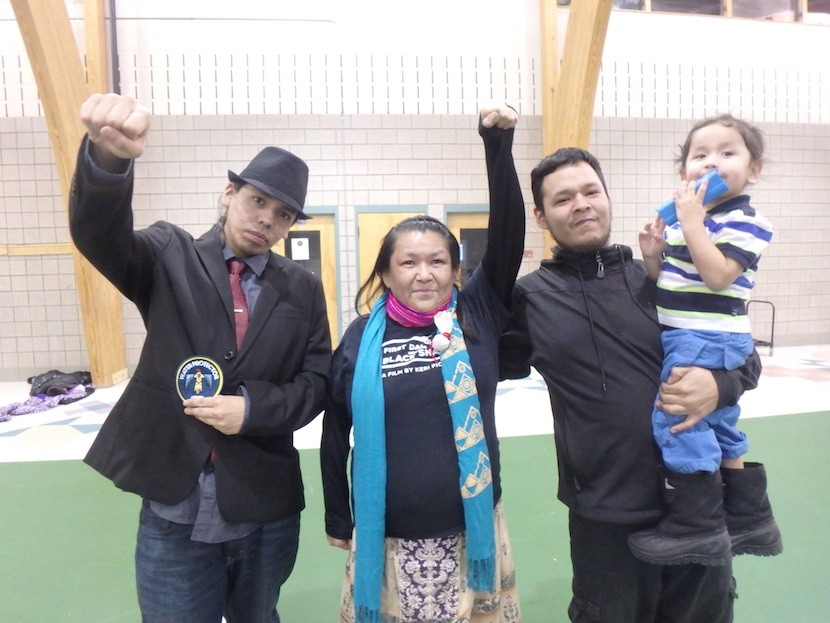
By Li Boyd Mille Lacs Band Member
On the evening of January 16, smoked fish and hominy soup opened the informational hearing for the draft Anishinaabe Cumulative Impact Assessment (ACIA) at the East Lake Community Center. The fish was locally sourced from the waters of Turtle Is- land and served as a reminder of what the ACIA was developed to protect. Tap water from the clean, local well was also served, to illustrate what is really at stake and under discussion in the pages of this document. It was written to address the Enbridge Line 3 Replacement project, but its creators hope it could serve as the foundation for much more.
District II Representative David ‘Niib’ Aubid opened the event with remarks in Ojibwemowin comparing corporations like Enbridge to the Wiindigoo — the evil spirit monster of Anishinaabe oral traditions. Winona LaDuke, whose organization Honor the Earth developed the ACIA in conjunction with the Minnesota Chippewa Tribe, followed with a summary of the document.
The ACIA is built around the understanding that Indigenous communities have fundamentally different values than those of the dominant corporate culture. Anishinaabe people are connected to the land in ways that the Minnesota state government doesn’t understand and can’t quantify. Yet mega-projects like Line 3 impact the land, and therefore the Anishinaabe, more than per- haps any industry in the region. The most crucial part of evaluating a project like Line 3 for approval is determining what existing conditions are and how much the project is likely to change them.
For the State, this is encapsulated in the Environmental Impact Statement, which weighs project costs, profits, and revenue against things like habitat loss, social justice, and potential serious risk. The State deals in numbers and studies — quantities that can be cataloged and compared. In the State’s system, everything, even the health and wellness of its residents, is reduced to a commodity versus a cost.
Indigenous understanding is concerned with the health of the village as a whole, the community’s spiritual well-being, and the robustness of the land and animals. Everything is connected. To this day, most Native community leaders prioritize spiritual health over economic concerns. The Anishinaabe duty is to each other and the earth, and the ACIA was created to evaluate Line 3 impacts by these standards.
With the release of the Draft Environmental Impact Statement and the subsequent release of the revised Final Environmental Impact Statement, it became clear that the State had no intention of addressing the concerns of Indigenous communities. The State suggested that impacts could be mitigated through education and pay-offs to affected communities.
Fortunately, Honor the Earth and the Minnesota Chippewa Tribe created their own assessment, which is diligently researched and crafted to fill in the blanks of the State’s reports. The document serves as a historical analysis and a framework for tribes to address the failings of the State regulatory process. Indigenous communities in the United States, including the Anishinaabe, have dealt with loss and inequity for generations, suffering undue trauma as a result of industrialization. The ACIA is a statement that the people will no longer be ignored in the State process. The people are speaking — telling the State and Enbridge that their oil and chemical projects are not welcome, and the ACIA is the most comprehensive supporting document for these arguments ever created.
The ACIA focuses on Anishinaabe knowledge that can’t be ex- pressed outside of a cultural context. The Anishinaabe connection to land is interwoven with spiritual beliefs and the understanding that the land, landscape, plants, and animals are all alive and have their own spirits. The Anishinaabe people have recognized these manidoo for as long as they have lived in this region, and though these things are intangible and unquantifiable, they are an imperative truth to Anishinaabe people. The people must care for the manidoo who, in turn, care for them, and it must be ensured that the ecosystem around these beings not be diminished. Enbridge has demonstrated no ability or even willingness to take on the responsibility of caring for and watching out for these beings. To the State and these industrial corporations, these Anishinaabe truths might as well be fanciful myths with no meaning.
Some might argue that historical trauma has little bearing on present-day events, but the comments made by Tania Aubid illustrate the link between past and present trauma. After Winona’s summary of the ACIA, Tania spoke about her experiences last year at Standing Rock during the resistance to the Dakota Access Pipeline. She recounted her experiences of an event in which the pipeline construction crews bulldozed sacred sites that had been recently reported to the State of North Dakota. “I witnessed them plowing up the ancestors,” Tania said. “That’s trauma. And Enbridge had a 28 percent hand in Standing Rock.”
Following Tania, Keenan Gonzales testified that the pipeline would affect “everything that makes Minnesota Minnesota” — water, fish, rice, trees, and game. He questioned society’s priorities, saying it would make more sense to invest in renewable energy.
Harvey Goodsky talked about his experience paddling the Mississippi from the headwaters to Big Sandy Lake. “The Mississippi alone, that one body of water alone, is enough to fight for,” he said.
“Thank you to those who showed up and those who put together the Anishinaabe Cumulative Impact Assessment.”
The ACIA is available in its entirety at mnchippewatribe.org/ impact_assessment.html.